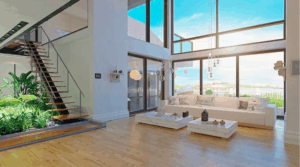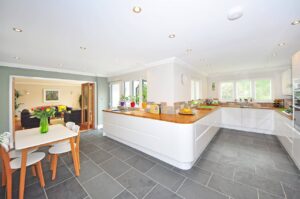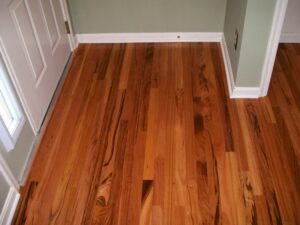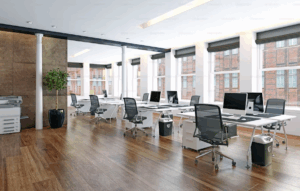Choosing among the various available kitchen flooring options is one of the most important decisions you’ll make when designing or remodeling your space. The kitchen isn’t just a place to cook; it’s where life happens. It deals with everything from spills and stains to heavy foot traffic and furniture movement.
So, how do you know which flooring option is best for your kitchen? With countless materials, finishes, and styles available today, the choice can feel overwhelming. That’s why we’re breaking it down, so you can make an informed and confident decision for your home or business.
Durable Kitchen Flooring Options for Busy Homes
Durability should always be a top priority when exploring flooring options for kitchen spaces. Kitchens are high-activity zones, and not all floors hold up the same way.
Materials like porcelain tile, LVT (luxury vinyl tile), and engineered wood offer excellent resilience. Tile is especially popular because it resists scratches and moisture. Vinyl, meanwhile, can mimic high-end looks while offering flexibility and impact resistance.
Engineered wood performs better in humid environments than solid hardwood, making it a smarter choice for Dubai’s climate.
Low-Maintenance Flooring Options for Kitchen Spaces
Different options for kitchen flooring require different levels of upkeep. If you love a spotless kitchen but have little time for scrubbing, low-maintenance materials are your best bet.
Vinyl and laminate are both incredibly easy to clean; just a quick sweep and mop does the job. Natural stone is beautiful but demands sealing and more frequent care. Hardwood may need refinishing over time, while tile grout can require deep cleaning to keep it looking fresh.
Stylish Yet Practical Kitchen Flooring Options
Looks still matter. Your kitchen flooring options should complement your cabinetry, walls, and overall interior vibe. But they must also perform under pressure.
Fortunately, modern flooring technology means you don’t have to choose between beauty and function. Stone-look porcelain tiles, waterproof laminate flooring with wood grain textures, and patterned vinyls give you elegant surfaces that still meet the rigors of everyday use.
Water-Resistant Options for Kitchen Flooring That Last
Whether you’re managing the occasional coffee spill or the nonstop demands of a family kitchen, your flooring needs to stand up to moisture without buckling, staining, or deteriorating over time.
Materials like vinyl, ceramic tile, and sealed concrete offer built-in protection against water. Their surfaces are non-porous, making them highly resistant to both liquid and humidity. These options not only prevent water damage but also help reduce the growth of mold or mildew, which is a bonus in humid environments.
By contrast, unsealed hardwood and untreated natural stone absorb moisture easily, which can lead to swelling, staining, or surface deterioration. Even a small spill left unattended can result in permanent damage. In commercial kitchen flooring options, the stakes are even higher.
Water-resistant materials are often required to meet health codes and ensure daily cleaning is efficient and effective. Moisture-resistant flooring supports both hygiene and safety, especially in fast-paced, high-traffic settings.
Best Kitchen Flooring Options for Hot Climates Like Dubai
In regions like Dubai, where high temperatures and dry conditions are the norm, choosing the right kitchen flooring means considering more than just looks. The best kitchen flooring options for hot climates help regulate indoor temperature and hold up against seasonal shifts in humidity.
Materials such as ceramic tile, porcelain, and polished concrete naturally stay cool underfoot. This not only enhances comfort during scorching summer days but also contributes to a more energy-efficient home by reducing the reliance on air conditioning.
Wood flooring, while visually warm and inviting, tends to retain heat and react to changes in humidity. Without proper sealing and acclimatization, it may expand, contract, or warp, making it a riskier choice in this environment.
Vinyl, however, offers a practical middle ground. It adapts well to fluctuating indoor climates, maintains a stable surface year-round, and remains comfortable in both warm and cooled spaces.
Comfort-Focused Best Flooring Options for Kitchen Use
Spending long hours in the kitchen prepping, cooking, or cleaning can take a toll on your feet and joints, especially if your flooring lacks support. Comfort becomes a key factor in high-use kitchens, where standing is part of the daily routine.
Hard surfaces like ceramic tile and natural stone, while durable and visually appealing, can feel unforgiving underfoot. Without anti-fatigue mats or cushioned footwear, these materials may lead to discomfort over time, particularly in open-plan homes where the kitchen blends into living spaces.
Vinyl flooring and cork, on the other hand, provide more give and shock absorption. They offer a softer surface that reduces pressure on the body, making them a thoughtful choice for busy households or anyone who enjoys long cooking sessions. Cork also adds a touch of natural warmth and insulation, further enhancing comfort.
Choosing the best flooring options for kitchen use means considering more than just durability or style; it means finding a material that supports both your body and your lifestyle every day.
Budget-Friendly Yet Reliable Kitchen Flooring Options
Every renovation comes with a budget, and kitchen flooring is no exception. While it’s tempting to choose the lowest-cost option, it’s important to look beyond the initial price tag. Flooring is a long-term investment, and what seems affordable today might cost more over time if it wears out quickly or requires frequent repairs.
Laminate and standard vinyl tend to be the most cost-effective choices upfront. They’re easy to install and maintain, and modern designs can mimic the appearance of wood, tile, or stone. For homeowners working within a tighter budget, these options can deliver style without stretching expenses.
However, premium materials like porcelain tile or engineered wood may provide greater value in the long run. Their durability can translate to fewer replacements, better performance, and increased home resale appeal.
In commercial kitchen flooring options, where downtime is expensive and wear is constant, investing in high-grade, low-maintenance materials often results in fewer disruptions and lower operational costs.
Balancing cost with reliability ensures your flooring holds up over time without compromising on function or aesthetic impact.
Comparing the Best Kitchen Flooring Options for Your Lifestyle
Ultimately, comparing kitchen flooring options means weighing every factor that matters to you: durability, maintenance, style, comfort, cost, and sustainability.
Your perfect kitchen floor isn’t just about trends or aesthetics. It’s about how the surface serves your day-to-day life. Whether you’re a busy parent, a restaurant owner, or a design enthusiast, the right flooring will support your lifestyle and enhance your space for years to come.
Choosing the right kitchen flooring options doesn’t have to be overwhelming. At Floor Guys Dubai, one of the leading flooring companies in the region, we guide our customers through each stage of the process, from selection to installation. Our wide range of materials and expert insight help ensure your kitchen floor is not only beautiful but also practical, durable, and tailored to your needs.
To get started on your kitchen upgrade, contact us at +971 585498158 or email sale@floor-guys.com. Visit us at Apricot Tower, Office 802-4, Silicon Oasis Dubai to explore your options in person.
Frequently Asked Questions
What is the most durable kitchen flooring material?
Porcelain tile and luxury vinyl are highly durable, resisting water, scratches, and impact. For commercial kitchens, epoxy or sealed concrete adds extra resilience. Always choose slip-resistant finishes to enhance safety in busy, spill-prone kitchen environments.
Can hardwood be used in kitchen flooring?
Yes, but engineered wood is preferred over solid hardwood due to better moisture stability. Proper sealing and regular maintenance are essential. Use rugs or mats near sinks and stoves to protect against water damage and high-use areas.
Is vinyl a good option for kitchens?
Vinyl is water-resistant, easy to clean, and affordable. It’s comfortable underfoot and comes in many styles. Choose options with a thick wear layer for added durability in high-traffic kitchens, whether residential or commercial.
How do I clean and maintain my kitchen flooring?
Sweep and mop vinyl or laminate regularly. Clean tile grout as needed. Seal stone floors for protection. Always follow manufacturer care guidelines and avoid harsh chemicals that can damage finishes or reduce your flooring’s lifespan.
Are there kitchen flooring options that are eco-friendly?
Yes. Bamboo, cork, reclaimed wood, and low-VOC vinyls offer eco-friendly options. Look for certifications like FSC or FloorScore to ensure sustainable sourcing and indoor air quality compliance while maintaining performance and style.






